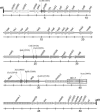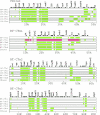Genetic and structural analysis of the Bacteroides conjugative transposon CTn341
- PMID: 15805532
- PMCID: PMC1070377
- DOI: 10.1128/JB.187.8.2858-2869.2005
Genetic and structural analysis of the Bacteroides conjugative transposon CTn341
Abstract
The genetic structure and functional organization of a Bacteroides conjugative transposon (CTn), CTn341, were determined. CTn341 was originally isolated from a tetracycline-resistant clinical isolate of Bacteroides vulgatus. The element was 51,993 bp long, which included a 5-bp coupling sequence that linked the transposon ends in the circular form. There were 46 genes, and the corresponding gene products fell into three major functional groups: DNA metabolism, regulation and antibiotic resistance, and conjugation. The G + C content and codon usage observed in the functional groups suggested that the groups belong to different genetic lineages, indicating that CTn341 is a composite, modular element. Mutational analysis of genes representing the different functional groups provided evidence for the gene assignments and showed that the basic conjugation and excision genes are conserved among Bacteroides spp. A group IIA1 intron, designated B.f.I1, was found to be inserted into the bmhA methylase gene. Reverse transcriptase PCR analysis of CTn341 RNA showed that B.fr.I1 was functional and was spliced out of the bmhA gene. Six related CTn-like elements were found in the genome sequences of Bacteroides fragilis NCTC9343 and Bacteroides thetaiotaomicron VPI5482. The putative elements were similar to CTn341 primarily in the tra and mob regions and in the exc gene, and several appeared to contain intron elements. Our data provide the first reported sequence for a complete Bacteroides CTn, and they should be of considerable benefit to further functional and genetic analyses of antibiotic resistance elements and genome evolution in Bacteroides.
Figures






Similar articles
-
Genetic and functional analyses of the mob operon on conjugative transposon CTn341 from Bacteroides spp.J Bacteriol. 2010 Sep;192(18):4643-50. doi: 10.1128/JB.00317-10. Epub 2010 Jul 16. J Bacteriol. 2010. PMID: 20639338 Free PMC article.
-
Identification of genes required for excision of CTnDOT, a Bacteroides conjugative transposon.Mol Microbiol. 2001 Aug;41(3):625-32. doi: 10.1046/j.1365-2958.2001.02519.x. Mol Microbiol. 2001. PMID: 11532130
-
Possible origins of CTnBST, a conjugative transposon found recently in a human colonic Bacteroides strain.Appl Environ Microbiol. 2007 Jul;73(13):4226-33. doi: 10.1128/AEM.00455-07. Epub 2007 May 4. Appl Environ Microbiol. 2007. PMID: 17483268 Free PMC article.
-
Conjugative transposition.Annu Rev Microbiol. 1995;49:367-97. doi: 10.1146/annurev.mi.49.100195.002055. Annu Rev Microbiol. 1995. PMID: 8561465 Review.
-
Regulation of CTnDOT conjugative transfer is a complex and highly coordinated series of events.mBio. 2013 Oct 29;4(6):e00569-13. doi: 10.1128/mBio.00569-13. mBio. 2013. PMID: 24169574 Free PMC article. Review.
Cited by
-
Extensive Mobilome-Driven Genome Diversification in Mouse Gut-Associated Bacteroides vulgatus mpk.Genome Biol Evol. 2016 Apr 25;8(4):1197-207. doi: 10.1093/gbe/evw070. Genome Biol Evol. 2016. PMID: 27071651 Free PMC article.
-
Integration and excision of a newly discovered bacteroides conjugative transposon, CTnBST.J Bacteriol. 2007 Feb;189(3):1072-82. doi: 10.1128/JB.01064-06. Epub 2006 Nov 22. J Bacteriol. 2007. PMID: 17122349 Free PMC article.
-
The Ellis Island Effect: A novel mobile element in a multi-drug resistant Bacteroides fragilis clinical isolate includes a mosaic of resistance genes from Gram-positive bacteria.Mob Genet Elements. 2014 Jul 14;4:e29801. doi: 10.4161/mge.29801. eCollection 2014. Mob Genet Elements. 2014. PMID: 25165618 Free PMC article.
-
Novel large-scale chromosomal transfer in Bacteroides fragilis contributes to its pan-genome and rapid environmental adaptation.Microb Genom. 2017 Nov;3(11):e000136. doi: 10.1099/mgen.0.000136. Microb Genom. 2017. PMID: 29208130 Free PMC article.
-
Natural competence is a major mechanism for horizontal DNA transfer in the oral pathogen Porphyromonas gingivalis.mBio. 2012 Jan 31;3(1):e00231-11. doi: 10.1128/mBio.00231-11. Print 2012. mBio. 2012. PMID: 22294679 Free PMC article.
References
Publication types
MeSH terms
Substances
Associated data
- Actions
Grants and funding
LinkOut - more resources
Full Text Sources
Molecular Biology Databases
Miscellaneous

